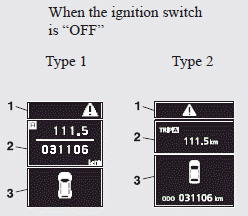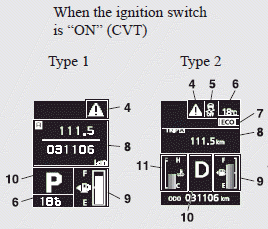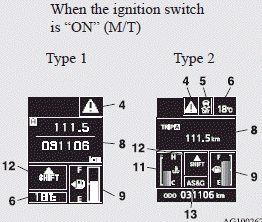Except for vehicles equipped with Twin Clutch SST
Always stop the vehicle in a safe place before operating.
The following information is included on the multi-information display: warnings, odometer, tripmeter, service reminder, engine coolant temperature, fuel remaining, outside temperature, selector lever position, average and momentary fuel consumption, driving range, average speed and meter illumination.
It is also possible to change elements such as the language and units used on the multi-information display.



1-mark display screen (when the ignition switch is “OFF”) ®
2- Information screen (when the ignition switch is “OFF“) ®
Interrupt display screen (when the ignition switch is “OFF”) ®
3- Door ajar warning display screen (when the ignition switch is “OFF”) ®
4- ACD (Active centre differential system) control mode display screen ®
5. Outside temperature display screen ®
6- mark display screen (when the ignition switch is “ON”) ®
7- Information screen (when the ignition switch is “ON”) ®
Interrupt display screen (when the ignition switch is “ON”) ®
8. Fuel remaining display screen ®
9- Twin Clutch SST control mode display screen ®
10- Engine coolant temperature display ®
11- Gearshift lever position display screen ®
12- Active Stability Control (ASC) OFF display screen ®
13. ECO mode indicator (except for vehicles for Russia, Kazakhstan and Ukraine)
®
See also:
Glove box
Type 1
1- To open, pull the lever.
Type 2
1- To lock 2- To unlock 3- To open, pull the lever.
NOTE
If the box is opened when the headlamps turn on, the glove box lamp illuminates. ...
Electric remote–controlled outside rear–view mirrors*
The outside rear–view mirrors can be operated when the ignition switch is in
the “ON” or “ACC” position.
Place the lever (A) to the same side as the mirror whose adjustment is desired.
...
Subaru Plans to Introduce 3 New EVs by 2026
Subaru has announced its intention to expand its electric vehicle (EV) lineup with three new all-electric SUVs by 2026. This initiative is part of Subaru's broader goal to sell 200,000 EVs globally ...
